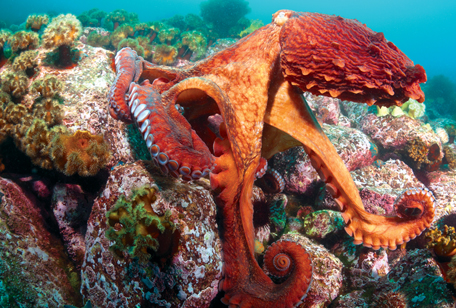
Enteroctopus dofleini
North to Alaska, South to Mexico
Not Listed
Aquatic Invertebrate
The Giant Pacific Octopus is the largest of the species. They have a hydrostatic skeleton which allows them to keep body parts rigid. They actually have no bones, backbone or vertebral column and they utilize the incompressible nature of water to transmit force; thus they are considered an invertebrate.
At Arm’s Length
This charismatic and intelligent cephalopod has four pairs of arms with approximately 280 suckers on each arm. These dynamic appendages create an acute sense of taste and touch along with natural danger and prey detectors. The octopus employs foraging techniques with its amazing arms allowing it to effectively and efficiently obtain favored foods like squid, numerous species of fish, clams and crabs.
Camouflage Expert
The Giant Pacific Octopus is able to transform its skin color to its surroundings. Typically reddish in color, it is able to change not only its color but also the texture of its body as camouflage to avoid danger. Octopi prefer solitary living and will cache themselves between boulders, rock crevices and dens in their watery habitats.
